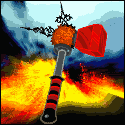|
Rexides, I really like that idea. Are monsters also subject to risk as well? Since all those tiny fiddly bits apply to PC actions as well. If you do, it seems like it would be easier to port over 4e's roles. How important are the 4 roles to people? As a player I really like having a clear idea what I'm supposed to be doing during a fight. I've tweaked them and clarified them a little bit for my own purposes. In my entry, Defenders and Strikers are both about the Hit Point economy. Defenders shunt damage around to where it will hurt the least (usually themselves), and strikers shunt damage to where the Monsters are most vulnerable. Controllers and Leaders are both about the action economy. Controllers are primarily about making monster turns as inefficient as possible and Leaders are about making the PC's turns as efficient as possible. Put another way: Defenders and Strikers try to make the PC to monster HP exchange rate as favorable as possible, and Controllers and Leaders try to make the PC to monster action exchange rate as favorable as possible.
|
|
|
|

|
| # ? Apr 29, 2024 19:04 |
|
Gau posted:Replacing Clerics with Bards in a fantasy game is my favorite swap. Bards kick so much rear end. Right? Clerics feel so at odds with the rest of the party, why not bring your own musical accompaniment instead?
|
|
|
|
wallawallawingwang posted:Rexides, I really like that idea. Are monsters also subject to risk as well? Since all those tiny fiddly bits apply to PC actions as well. If you do, it seems like it would be easier to port over 4e's roles. Generally player actions are too significant (compared to, say, a minion's attack) to abstract with such a mechanic, with the exception of out-of-turn attacks (like OA), which are bad because they interrupt play and draw out the combat length. So I am going to have a similar mechanic (but not the same) to abstract these kind of things. wallawallawingwang posted:How important are the 4 roles to people? As a player I really like having a clear idea what I'm supposed to be doing during a fight. We had a big argument in one of the older D&D Next threads about the validity of the striker role. Since "Make HP go down" is the central mechanic of combat, some of us felt that all members of the party should be able to contribute to it equally. I think that Misandu is on to something here, as all his classes have certain conditions where they do big damage, and the combat mini-game is about making those conditions happen. You could also have a "striker" role that does the same damage as the rest, but excels at slipping past soldiers and brutes to deliver that damage to enemy controllers, however if you do that you end up with a role that is only relevant when that particular configuration of enemies is present, which is not good.
|
|
|
|
Right, here are my inane ramblings on the nature of this hack I'm doing. it's got my initial thoughts on what I want the hack to work like, and a writeup of the Heavy role. The basic idea, for those of you who can't translate my rough notes, is that it's going to function kind of like a hybrid or gamma world setup, where you pick a Background (Such as cyborg, rookie, xenobiologist) and a Role (heavy, sergeant, sniper). Role determines your role (heavy is a Defender, for example) while background functions more like a theme/race package. I still need to work out the basic maths of how attack bonuses and defenses and such scale, but I figure getting started will encourage me to do that. Feel free to savage my terrible ideas and tell me why they suck.
|
|
|
|
Captain Hats posted:Feel free to savage my terrible ideas and tell me why they suck. For a 4e-Com game, I'd assume that dailies and encounters (really everything would be per mission or at-will) would mostly be based on your equipment load out, with role and class modifying how you use equipment. Like a sniper gets extra range when using a rifle, but an assault gets a wicked bayonet charge when using the same rifle. Anyone can toss a smoke grenade, but strikers can see through the smoke better and deal extra damage to enemies in the smoke, but leaders can use the grenade to provide cover for their allies so they can safely shift around. I'm certainly not a great and renowned designer, but I was dicking around with a similar idea a bit ago so maybe some of the ideas I was messing with might spark something. -I changed the assumed size of squares from 5 feet to 10 feet, so gun ranges were a bit longer in fictional terms but could work with a 20/40 square upper range limit found in the base game. It also lets a vehicle going 40 MPH have a speed of 36 squares (really high but still something you can show on a large battlemat) instead of 72 squares (why bother tracking distance at that point). -To reinforce the importance of cover, I changed the standard defense from AC to Cover. There were 3 types of cover: Open: basically no cover, Normal: rubble, rocks, trees and furniture to hide behind, Heavy: Behind a sandbag barricade. The assumption being that squares were normal cover unless otherwise noted. Certain classes would get bonuses depending on the degree of cover they had. Scouts for example would get extra movement and a small bonus to cover when they were out in the open. -Armor basically worked by giving you a save to negate a hit you took. Better armor gave you bonuses to the roll, and let you use the armor more often. Role Chat: I agree that if any of the roles had to go, it'd be striker. When the rest of the group is hitting and buffing allies to hit better, hitting and debuffing enemies to hit worse, and hitting while ensuring the toughest attacks go to the toughest target Hitting, but harder, seems kind of lazy. The tweak of hitting as hard as anyone else but hitting where it hurts most, gives you the same effect of defeating the monsters faster but also gives the striker a specific goal that won't overshadow anyone else. Mobility and range are good starts, but like it was mentioned before aren't enough. Spit balling some ideas here. -Overkill: When this striker takes an enemy to below 0 HP the excess cleaves into another nearby enemy. This lets them not have to worry about wasting an encounter or a daily on a weakened monster, provided another enemy is near they can't waste damage. It also gives you neat little tactical situations where you are better off attacking the bosses minions instead of the boss. Their effective average damage goes up, without having to increase their maximum or minimum. -Harrier: Even when their attacks don't work well a cavalcade of smaller attacks means they still do a decent amount of damage on a miss. When their attacks do hit, they carry debuffs that increase the odds of players hitting/hurting their target. Since their attack action is never wasted they have incentives to go after high defense/buffed targets. When they get lucky and hurt them it gives the other players a chance to dogpile them. -Throat Slitter: Anytime they successfully attack a standard bloodied enemy, they finish them off. This might be too similar to the overkill guy, but it lets the rest of the players focus fire for a round or two, and then quickly move on. It also makes cleanup a snap. These are all pretty rough. I might use them in my entry, but feel free to use/adapt/mock anything here.
|
|
|
|
On RoleChat, I have made up for it by not making each Striker "do a bunch of damage" as their class idea. The Scout is sneaky as poo poo and can slip away at the slightest notice, and when she's close to you she'll knife you in the throat. The Gunner sprays bullets loving everywhere, and as such is really good at doing damage to groups of enemies. I threw together the Scout class today, you can find it here in my living work-in-progress document. I've enabled commenting so like, have at. I want to know what works and what doesn't.
|
|
|
|
Thoughts on "roll under" abilities in place of skills? They fill the same rolls anyway in the framework, in some sense. Strong guy does strong stuff 90% of the time.
|
|
|
|
Roll under stats in the D&D standard range is elegant, but unless you change the way you do other checks, it'll feel a little odd to mix roll-under with roll-add-over.
|
|
|
|
wallawallawingwang posted:How important are the 4 roles to people? As a player I really like having a clear idea what I'm supposed to be doing during a fight. Rexides posted:We had a big argument in one of the older D&D Next threads about the validity of the striker role. Since "Make HP go down" is the central mechanic of combat, some of us felt that all members of the party should be able to contribute to it equally. I think that Misandu is on to something here, as all his classes have certain conditions where they do big damage, and the combat mini-game is about making those conditions happen. In the unnamed RPG I wrote up, I went more the direction of "Defenders are a specialized kind of controller" and while Strikers are just "Most Damage" they rely on teamwork. Granted, it should be pretty easy to get your striker features to work (I kinda intentionally made it kitchensinkish, rather than ROGUES WANT FLANK/AVENGERS ROLL TWICE) but basically they go good with Leaders or Defenders... and Controllers (to a lesser degree), but all in different ways. I also made Defenders able to maim enemies, in case they are for some reason in a situation where marking is pointless (i.e. 1v1 combat) It's also intended to be played with a 3-man party. Further to that point, "HP recovery" is a thing anyone can do for themselves; if a leader lets you do it, they either help you regain a little bit more, or spend their surges instead of yours. But basically, I wanted to make the Leader role more about enabling teammates, and without just being +X when you Y. P.d0t fucked around with this message at 07:27 on Jul 9, 2014 |
|
|
|
Asymmetrikon posted:Roll under stats in the D&D standard range is elegant, but unless you change the way you do other checks, it'll feel a little odd to mix roll-under with roll-add-over. Alternatively, if you don't give any fucks about "unified mechanics", just do roll-under Ability Mods and use a d6 for check rolls. You can increase the die size for harder DCs, like d8, d10, etc. Sucks if you have negative mods, but IMHO D&D should really stop doing that. P.d0t fucked around with this message at 07:26 on Jul 9, 2014 |
|
|
|
I wanted to ask some opinions of the thread on my writeup about ability scores.What I wrote posted:Ability scores affect eight areas of Dungeons & Dragons: Do I have most of the issues surrounding ability cores? Are there any more? Do you Agree/Disagree with the claim that getting rid of ability scores would require a redesign of the eight areas?
|
|
|
|
Torchlighter posted:I wanted to ask some opinions of the thread on my writeup about ability scores. That's pretty much it, aside from Ability Checks, which come up more or less often depending on the type of game. As an aside, you can basically include Initiative as a Skill in 4e; it's just impossible to get as a class skill or gain Skill Focus in (Improved Initiative is basically Skill Training.) The other thing to consider is that while you mostly use Mods for actually doing stuff (as you mentioned CON score matters, STR score also matters for carrying capacity) but they take the mods and add a bunch of poo poo to those to get the "correct, expected values" anyway. Just give us the Expected Values math and gently caress all the obfuscation.
|
|
|
|
In regards to DTAS - I don't think it's redesigning those areas so much as 're-mathing' them. Take away the expected +5 to primary abilities and +3 to next-as-good and then make sure the numbers are right.
|
|
|
|
P.d0t posted:Alternatively, if you don't give any fucks about "unified mechanics", just do roll-under Ability Mods and use a d6 for check rolls. Obviously, if you went this route you should drop the 3-20 stats and just use the mods. An alternative for harder DCs = larger dice would be just applying a +bonus to the roll.
|
|
|
|
What else would you make checks for? Outside of skill checks, I can't really think of anything. Using roll under for abilities is a pretty elegant system that actually makes ability scores significant.
|
|
|
|
Attack rolls, for one, unless you convert those to roll-unders as well (you'd have to rework how attack bonus & defenses work, but it probably wouldn't be too hard).
|
|
|
|
Does anything else? I can only think of saves, and roll under ability (con or whatever) would work pretty darn well for that. I am referring only to death saves, because any other saves suck. Save or X abilities do too.
|
|
|
|
Asymmetrikon posted:Attack rolls, for one, unless you convert those to roll-unders as well (you'd have to rework how attack bonus & defenses work, but it probably wouldn't be too hard). Just off the top of my head: defenses subtract from the roll's target number, making it harder to roll under. You have a Strength of 16, hitting a guy with an AC of 4 means you have to roll under 12.
|
|
|
|
Right - alternately, you can add the defense to your roll (which is mathematically the same as subtracting from the target) if you don't want to include subtraction.
|
|
|
|
Something I've been ruminating on in a 4E context is combat math on the player side. Monster math is pretty well laid out thanks to MM3 on a business card but in the context of designing a 4E clone or 4E inspired game, it's something to note that unlike other RPGs where you can have "a combat guy" and then other characters kind of along for the fight, every character in a 4E party is "a combat guy" just in their own way, and numerically every 4E character's to-hit math should be roughly in line (assuming the GM is giving out free expertise/using inherent bonuses which, y'know, they should). That is to say every weapon user should be rolling roughly the same to-hit against AC or whatever and every implement user should be rolling around the same to-hit against NADs. So I guess the question I have, thinking about all this, is that if you're trying to make a 4E clone of some sort, is there any reason to not simply make base to-hit math universal for all characters?
|
|
|
|
I think it depends on what you mean by making the math universal. I don't see much point in the disparity between AC and the NADS, but I suspect that is rooted in the disparity between how the system treats implements and weapons. But there is some value to having enemies that are more or less vulnerable to certain kinds of attacks, like huge bruisers with high AC and fort, but low will and reflex. I also think there is something to be said for highly accurate being a cool shtick, so long as highly accurate means in certain, but by no means universal, circumstances you get to do something cool and unique to increase your odds of doing damage. The Avenger's oath is a lot cooler than Fighters getting to numberwang on a 7 instead of an 8.
|
|
|
Kai Tave posted:Something I've been ruminating on in a 4E context is combat math on the player side. Monster math is pretty well laid out thanks to MM3 on a business card but in the context of designing a 4E clone or 4E inspired game, it's something to note that unlike other RPGs where you can have "a combat guy" and then other characters kind of along for the fight, every character in a 4E party is "a combat guy" just in their own way, and numerically every 4E character's to-hit math should be roughly in line (assuming the GM is giving out free expertise/using inherent bonuses which, y'know, they should). That is to say every weapon user should be rolling roughly the same to-hit against AC or whatever and every implement user should be rolling around the same to-hit against NADs. You lose out on the glorious scale of getting big numbers, and being able to defeat things you were too weak to even damage before. For a game the scale of which a single person can make in a month, there's really no draw back.
|
|
|
|
|
I am making a thing, it's called 4minimum and will probably be bad.
|
|
|
|
wallawallawingwang posted:I think it depends on what you mean by making the math universal. I don't see much point in the disparity between AC and the NADS, but I suspect that is rooted in the disparity between how the system treats implements and weapons. But there is some value to having enemies that are more or less vulnerable to certain kinds of attacks, like huge bruisers with high AC and fort, but low will and reflex. I also think there is something to be said for highly accurate being a cool shtick, so long as highly accurate means in certain, but by no means universal, circumstances you get to do something cool and unique to increase your odds of doing damage. The Avenger's oath is a lot cooler than Fighters getting to numberwang on a 7 instead of an 8. What I mean is that if you have, say, a Ranger, a Bard, a Fighter, and an Avenger (let's say starting out in early heroic tier) in a 4E party and all of them have an 18 in their primary combat stat, plus all of them have an expertise feat or the equivalent thereof, and let's say they're all using a +3 proficiency weapon because to-hit value is so important, then all of their to-hit values should essentially be within 1 of each other. That is to say that for all the math that an individual player (or character building program) might do to derive a 4E character's attack value that when you get right down to it there doesn't really seem to be a whole lot of point to actually going through all of that instead of just saying "every character attacks at +X" and leaving it at that. Part of this is "death to ability scores" I guess since tying combat values to ability score values is sort of dumb for reasons that Torchlighter kind of touched on. Part of this is noting that unlike in other RPGs, 4E fully expects everybody in an adventuring party to be participating in a fight equally...it's not "the Fighter fights, the Wizard actually ends the encounter, the Bard hides behind a rock and maybe plays a song," everybody is participating on an equal level, and as a result 4E works to give everybody roughly equal chances to hit in combat. But because of that it seems to me that 4E goes through a lot of unnecessary steps to arrive at that point. So that's why I'm asking, since we've got a lot of people theory- and kitbashing here, if there's some point to how 4E handles this that I'm missing or if it really is largely as pointless as it seems? (The glory of bigger numbers is also kind of an issue that 4E runs into where yeah sure, numbers get bigger as you go up in level but the general range of values between player numbers and monster numbers stay roughly equivalent so it feels pretty much like a treadmill. I guess if you've got a hankering to go splat some enemies 5 levels lower than you it might matter but 4E is at its most enjoyable when you're fighting enemies at levels roughly equivalent or higher than your party level, so I think you could flatten that number creep and not do much to adversely affect the actual play experience.) I agree that the disparity between AC and the non-AC defenses is kind of weird when you dig right down into the reasoning behind it, but I also agree that monsters having variable defense ratings in different areas gives players an additional tactical consideration when fighting them so I'd be inclined to keep it in some form or fashion.
|
|
|
|
Kai Tave posted:But because of that it seems to me that 4E goes through a lot of unnecessary steps to arrive at that point. So that's why I'm asking, since we've got a lot of people theory- and kitbashing here, if there's some point to how 4E handles this that I'm missing or if it really is largely as pointless as it seems? Between ability score increases, feats, magic items, and of course the +1/2 level bonus, PCs are expected to have +1/level to hit and defenses (before proficiency and class bonuses) Kai Tave posted:I agree that the disparity between AC and the non-AC defenses is kind of weird when you dig right down into the reasoning behind it, but I also agree that monsters having variable defense ratings in different areas gives players an additional tactical consideration when fighting them so I'd be inclined to keep it in some form or fashion. As we discussed in another thread, the problem is that variable defenses in a binary resolution system is not such a good idea. Sure, you do have more chances scoring a hit against a weak defense, but since the two different outcomes are exactly the same as attacking a strong defense (Hit/No Hit, or rolling 18 vs DC 18 has the same effect as 18 vs DC 11), it makes you question the validity of that particular rule combination on a turn-by-turn basis. For people who want to have variable defenses in their systems, I suggest the following: a) Have a more granular resolution mechanic, or b) Have different effects vs different defense strength. Personally I'll go with b because I think it's nice to reward a player for picking the weak point by providing an additional bonus to his effect. For example, a creature with weak Fort might get a penalty to movement if he was hit with a vs. Fort power, or one with a weak Will might get a penalty to damage with vs. Will powers.
|
|
|
|
Naw you're totally right. There isn't much reason to make huge attack modifiers and defense modifiers; the only reason you might want to scale them up by level is to throw below-level monsters at a party to have a fight be bigger. I mean, the whole point of NADs is for people to feat-cheese and make their BAs hit REF or similar such bullshit, which is really just a roundabout, obfuscated "+X to attack, yet again."
|
|
|
|
Rexides posted:As we discussed in another thread, the problem is that variable defenses in a binary resolution system is not such a good idea. Sure, you do have more chances scoring a hit against a weak defense, but since the two different outcomes are exactly the same as attacking a strong defense (Hit/No Hit, or rolling 18 vs DC 18 has the same effect as 18 vs DC 11), it makes you question the validity of that particular rule combination on a turn-by-turn basis. Well 4E sort of approaches option B in a roundabout way by having a variety of powers and abilities with different effects and targeting different defenses. For example, if I'm playing a Monk then some of my attacks target Reflex and some target Fortitude and so if I'm attacking an enemy I may have to decide whether I want to try and go for the surer thing and target the lower defense or if I'd rather have the effect/ability of this technique over here and risk a slightly lower chance of landing the attack. I think there's some interesting design space to be considered in having monsters with special reactions to attacks that land on different defenses though, that's a pretty cool idea.
|
|
|
|
Ok, so I haven't done much, but I've gone through and done a breakdown of the classes. Essentially I took a basic fighter, rogue, wizard and warlord and split their powers and class features into various pieces of gear. So, if you bought the right pieces, you would wind up with the equivalent of a Guardian Fighter from the PHB, except I'm converting this to a sci-fi-ish thing so you'd have a shotgun instead of a big sword/shield. Of course, you don't have to build that way. Mixing and matching parts is the name of the game here. I'm working on assigning a cost to each piece of equipment based on what it gives the character. There aren't going to be any classes in the classic sense, but I plan to have a few background options that'll make your character start with various boosts to Stats, Skills, Money, or effectiveness with certain types of equipment. This is probably still going to suck, but hey it'll at least be a new way to make multi-class type characters. Just as an example of what I mean, here's the fighter/rogue breakdown: Fighter Weapon Shotgun --Sure Strike --Tide of Iron --Combat Challenge Class Feature Armor Heavy --Comeback Strike Special Targeting H.U.D. --Covering Attack --Combat Superiority Class Feature --Fighter Weapon Talent Class Feature Adrenaline Pump --Unstoppable Rogue Weapon Rifle --Piercing Strike --First Strike Class Feature Armor Light --Deft Strike --Artful Dodger Class Feature Special Flash Rounds --Positioning Strike Remote Shock Darts --Trick Strike Stealth Band --Fleeting Ghost Enhanced Optics --Rogue Weapon Talent Class Feature --Sneak Attack Class Feature Now, this all leaves room for some wackiness, like a heavy armored, sneak attacking, flamethrower toting brute, but I think I'm okay with that. Just gotta work on redesigning the powers to fit thematically and to work with ranged weaponry and such. I'm also going to pull some random powers from other sources to spice thing up. I especially need to add in some melee options, because what sci-fi rag-tag crew of mercenaries doesn't have the crazy dude with a katana?
|
|
|
|
A few years back I did some reverse engineering on the 4e weapons. This is what I came up with: Weapons are built with points. A simple 1 hander is built with 7-9 points. A simple 2 hander is built with 9-11 points. A military 1 hander is built with 10-11 points. A military 2 hander is built with 13-14 points. A superior 1 hander is built with 11-13 points. A superior 2 hander is built with 15-16 points. Each half point of average damage is worth 1 point, including average damage that comes from the brutal property. (2d4 and 1d8 Brutal 1 both cost 10 for example) A +3 proficiency mod is worth 2 points. The High Crit feature is worth 1 point. Off hand is worth 2 points. Thrown is worth 2 points. The range seems.. totally arbitrary and made up. Reach is worth 3 points. Versatile looks like it is free. Belonging to more than one weapon group is free. Ranged weapons require a LOT more speculation since there are fewer examples to work with. Ranged weapons get, for free, load minor and a range of 10/20, 15/30, 20/40 depending on simple, military or superior. Adding 5/10 to a ranged weapons range is worth 1 point. Free reloads costs 2 points. The reload of a repeating crossbow costs 1 point. No real idea what small is worth, maybe 2 points? Is anyone else oscillating between doing a modest rules cleanup and just using 4e as a base for something totally different?
|
|
|
|
wallawallawingwang posted:Is anyone else oscillating between doing a modest rules cleanup and just using 4e as a base for something totally different? Personally, I'm still trying to figure out a comfortable boundary between "4e-based" and not 4e. Like, what makes 4e 4e, if you get my drift.
|
|
|
|
I'm just gonna slap fantasy over gamma world and do a really half assed job. Whats a better name, Basic 4E, or Gamma Dragons?
|
|
|
|
Asymmetrikon posted:Personally, I'm still trying to figure out a comfortable boundary between "4e-based" and not 4e. Like, what makes 4e 4e, if you get my drift. For me it was always tactical strategy and teamwork to beat fights. That and encounters taking for loving ever.
|
|
|
|
Lord Frisk posted:Gamma Dragons Do you need to ask? 
|
|
|
|
I'm not sure if its just my deep seeded need to procrastinate, but distilling the essence of 4e before I move on is a good idea. Especially since I've mostly been thinking about what doesn't work or is missing in the game, rather than what does work or is present. Next has made it a dirty word, but 4e does have a feel in addition to its core rules. Tummyfeels: -There aren't fights, there are battles, especially after the mm3 patch. Big set pieces with unique terrain and unusual circumstances seem to be the most satisfying way to build combat encounters. Compared to other editions, it's difficult to trivialize most fights, nova-debuffing a solo being a notable exception. However, a well made character can still get into a lot of trouble or even die if they are poorly played or have a run of bad luck. -It's a D20 game and that means throwing fistfuls of dice. -There is a sense that characters grow in competence and power. When my wizard got the ability to open up long range portals more or less at will, it really gave me that growth in power tummyfeel. Sometimes the math undercuts this though, and you go from need to make 4 20 HP hits to needing to make 4 80 HP hits. -4e nicely avoids the shitfarmer phase. Except for odd-ball builds that needed a specific set of feats and equipment to work, characters felt like they worked right from level 1. Actual rules: -Discrete highly defined, rules written with an eye for clarity and ease of play at the table. -Characters take their entire turn at once, and the sub-actions within each turn is governed by a strict action economy. Contrast that with the phases in Warhammer, or Action Points in the first X-Com, or even 3rd eds much looser action economy. -At least 3 rolls before PCs risk death. Save or die has been replaced with a successful attack followed by two failed saves. Very few monsters do enough damage to risk one shot-ing an equal level PC, even on a crit. -Characters seem to hit more or less on 8 +- 2. -Degree of success in combat is distributed across a couple of different areas. The attack roll provides miss/hit/crit, the power helps determine what those 3 conditions mean, but the damage roll is probably the key component of combat degree of success. -Character creation works rather like magic: the gathering deck building, in that you fill limited slots with chunks of ability, with an eye for both the chunk's inherent power and its ability to synergize with your other chunks. There are limits and buffers on both the slots and the numbers that keep this from being completely terribly breakable. -PC's being most effective when they work together in combat.
|
|
|
|
wallawallawingwang posted:A few years back I did some reverse engineering on the 4e weapons. This is what I came up with: I'll have to dig through this more to see if it fits my needs, but you may have just saved me a boatload of time right here. I hope you're cool with me borrowing this info.
|
|
|
|
Yeah, go for it. I figure if I post something here in the thread it is for public use. When I get a draft of my entry written up I'll just post a link to it. I'm least sure about ranged weapons with this system, but these should work well for laser-katanas and the like. Here are some modernish weapons from an unfinished 4e modern conversion I was working on. The clip property meant that if you rolled that number of lower on an attack, you couldn't use another attack power with that weapon until you spent a move action to reload the gun. I think clip 2 was the free default, but clip 4 gave you an extra point to play around with. Less than lethal just meant that if your brought something to 0, you had to KO it. I think I also was going to house rule Versatile to deal 1 extra damage per [W]. weapon name | prof | [w] | range | group | properties simple one handed melee baseball bat | +2 | 1d8 | mace | versatile pepper spray| +3 | 1d4 |less than lethal | reach, offhand military one handed melee tonfa | +2 | 1d8 | mace and unarmed | off hand superior one handed melee power drill | +2 | 1d8 | power tool | brutal 2, high crit superior two handed melee chainsaw | +2 | 1d12 | power tool | brutal 2, high crit simple one handed ranged sawed off shotgun | +3 | 1d8 | 5/10 | shotgun | load minor light revolver | +2 | 1d6 | 10/20 | pistol | clip 4, off hand heavy revolver | +2 | 1d8 | 10/20 | pistol | clip 4, versatile taser | +2 | 1d6 | 3/6 | less than lethal | simple two handed ranged pump shotgun | +3 | 1d8 | 10/20 | shotgun | clip 2 double barred shotgun | +3 | 1d10 | 10/20 | shotgun | load minor hunting rifle | +2 | 1d10 | 15/30 | rifle | clip 2 carbine | +2 | 1d8 | 10/20 | rifle | clip 2, small military one handed ranged light semi-auto pistol | +2 | 1d8 | 10/20 | pistol | clip 2, off hand heavy semi-auto pistol | +2 | 1d10 | 15/30 | pistol | clip 2 light SMG | +2 | 1d8 | 10/20 | auto | clip 4, brutal 1 full auto pistol | +3 | 1d6 | 10/20 | pistol, auto | clip 4, versatile military two handed ranged SMG heavy | +2 | 1d8 | 15/30 | auto | clip 4, small, brutal 1 sniper rifle | +2 | 1d10 | 30/60 | rifle | load minor combat shotgun | +3 | 1d8 | 10/20 | shotgun | clip 2, high crit assault rifle |+3 | 1d10 | 20/40 | rifle | clip 2 SAW | +2 | 1d12 | 10/20 | auto | clip 4 superior two handed ranged minigun | +2 | 2d6 | 20/40 | auto | clip 2 anti-material rifle | +2 | 1d12 | 30/60 | rifle | clip 2
|
|
|
|
I'm probably going to just ignore ammo for the time being. I was thinking about having a system where if you attacked multiple times in a turn for any reason you'd have to spend time reloading, but we'll just have to see. I really like your clip idea walla, very elegant.
|
|
|
|
lord_daeloth posted:I'm probably going to just ignore ammo for the time being. I was thinking about having a system where if you attacked multiple times in a turn for any reason you'd have to spend time reloading, but we'll just have to see. I really like your clip idea walla, very elegant. I think you might want to look at something like you have to spend a certain amount of time to reload, but you never have to really keep track of 'ammo' in the form of "I have X bullets on me." Doing a Ranged Basic Attack with a gun will never trigger a reload, but it doesn't do anything impressive either. So make reload a specific action attached to gun attacks and powers like when double attacks, or fire full auto, or guns akimbo or whatever. So a very slow reloading weapon like a sniper rifle would be Reload: Standard meaning you have to spend a standard action to reload (you still have a move and minor where necessary though, not to be too dickish) and you can have different Reload Speeds for different weapon classes, etc.
|
|
|
|
I dunno if I'll have the time to get this done by the end of the month, but I've got sort of the basic ideas hashed out:
|
|
|
|

|
| # ? Apr 29, 2024 19:04 |
|
So I've realized I have no interest in rehashing Paragons again. Instead I'll be completing a playable edition of Quest of the Wizard, Dagon's RPG about being aristocratic casters. It will have nothing to do with 4e and ya'll can just deal.
|
|
|
|


























